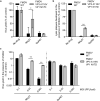Adaptive value of foot-and-mouth disease virus capsid substitutions with opposite effects on particle acid stability
- PMID: 34873184
- PMCID: PMC8648728
- DOI: 10.1038/s41598-021-02757-3
Adaptive value of foot-and-mouth disease virus capsid substitutions with opposite effects on particle acid stability
Abstract
Foot-and-mouth disease virus (FMDV) is a picornavirus that exhibits an extremely acid sensitive capsid. This acid lability is directly related to its mechanism of uncoating triggered by acidification inside cellular endosomes. Using a collection of FMDV mutants we have systematically analyzed the relationship between acid stability and the requirement for acidic endosomes using ammonium chloride (NH4Cl), an inhibitor of endosome acidification. A FMDV mutant carrying two substitutions with opposite effects on acid-stability (VP3 A116V that reduces acid stability, and VP1 N17D that increases acid stability) displayed a rapid shift towards acid lability that resulted in increased resistance to NH4Cl as well as to concanamicyn A, a different lysosomotropic agent. This resistance could be explained by a higher ability of the mutant populations to produce NH4Cl-resistant variants, as supported by their tendency to accumulate mutations related to NH4Cl-resistance that was higher than that of the WT populations. Competition experiments also indicated that the combination of both amino acid substitutions promoted an increase of viral fitness that likely contributed to NH4Cl resistance. This study provides novel evidences supporting that the combination of mutations in a viral capsid can result in compensatory effects that lead to fitness gain, and facilitate space to an inhibitor of acid-dependent uncoating. Thus, although drug-resistant variants usually exhibit a reduction in viral fitness, our results indicate that compensatory mutations that restore this reduction in fitness can promote emergence of resistance mutants.
© 2021. The Author(s).
Conflict of interest statement
The authors declare no competing interests.
Figures





Similar articles
-
Engineering Responses to Amino Acid Substitutions in the VP0- and VP3-Coding Regions of PanAsia-1 Strains of Foot-and-Mouth Disease Virus Serotype O.J Virol. 2019 Mar 21;93(7):e02278-18. doi: 10.1128/JVI.02278-18. Print 2019 Apr 1. J Virol. 2019. PMID: 30700601 Free PMC article.
-
Equine Rhinitis A Virus Mutants with Altered Acid Resistance Unveil a Key Role of VP3 and Intrasubunit Interactions in the Control of the pH Stability of the Aphthovirus Capsid.J Virol. 2016 Oct 14;90(21):9725-9732. doi: 10.1128/JVI.01043-16. Print 2016 Nov 1. J Virol. 2016. PMID: 27535044 Free PMC article.
-
Role of a single amino acid substitution of VP3 H142D for increased acid resistance of foot-and-mouth disease virus serotype A.Virus Genes. 2016 Apr;52(2):235-43. doi: 10.1007/s11262-016-1294-1. Epub 2016 Feb 12. Virus Genes. 2016. PMID: 26873406
-
The pH stability of foot-and-mouth disease virus.Virol J. 2017 Nov 28;14(1):233. doi: 10.1186/s12985-017-0897-z. Virol J. 2017. PMID: 29183342 Free PMC article. Review.
-
Cell Culture Adaptive Amino Acid Substitutions in FMDV Structural Proteins: A Key Mechanism for Altered Receptor Tropism.Viruses. 2024 Mar 27;16(4):512. doi: 10.3390/v16040512. Viruses. 2024. PMID: 38675855 Free PMC article. Review.
References
-
- Vazquez-Calvo A, Saiz JC, McCullough KC, Sobrino F, Martin-Acebes MA. Acid-dependent viral entry. Virus Res. 2012;20:20. - PubMed

